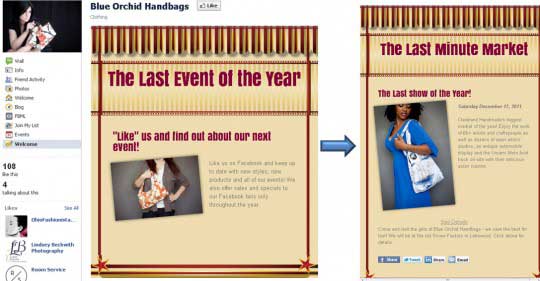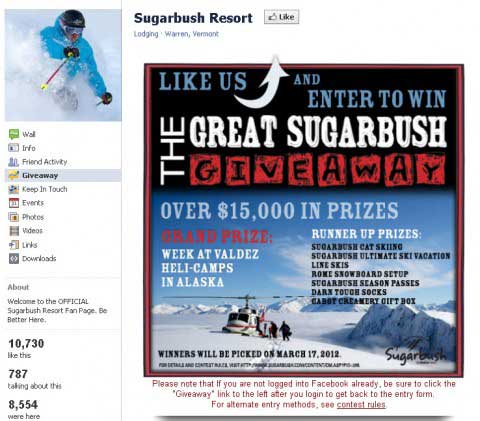Editor's note: By the time this article was published, Facebook had implemented its mandatory Timeline update for Brand Pages; accordingly, some of the material in this article is no longer relevant (such as the Welcome Page "Like" campaigns and "Like-gating").
Many small businesses and organizations already know that social media is one of the best ways to connect with customers and prospects. Unfortunately, many forget the "marketing" in social media marketing and think social media success is just about posting content and getting as many people as possible to "Like" their Facebook fan page or follow them on Twitter.
The truth is... to get real business results from your social media efforts, you need to set your goals higher than just getting more fans and followers. To maximize your investment in social media, you need to build a community, engage your audience, and (ideally) create word-of-mouth by compelling your audience to share your message with their networks of friends.
One of the best ways to accomplish those goals is to run a social campaign on Facebook.
What is a social campaign?
A social campaign is a way to apply proven inbound marketing strategies to social media, and it's a great way to take your social media marketing beyond just posting status updates and tweets.
Running a social campaign is easy, but it requires that you use a third-party application to install a tab on your Facebook page. Once you install a tab on your Facebook page, you can publish an offer or a piece of engaging content that is designed to get your fans to take a specific action (e.g., buy something, make a donation, download a whitepaper, print a coupon, watch a video, or register for an event).
If you want, you can "Like-gate" your offer, requiring users to "Like" your Facebook page in exchange for a free download. But getting more "Likes" is only one benefit of running a social campaign. An effective campaign should get users to participate and share your offer or content with their friends.
Why? Because, as marketers, our goal is to get people to take an action that will lead to real business results. Getting someone to "Like" you is really just list-building. What really matters is what you do with your fans. For example, if you lead a fan to print a coupon, chances are she will buy something from you.
Moreover, if you can also get that fan to share your offer, you will likely attract new fans and prospects—and, therefore, potential new business. In short, consumers trust recommendations from friends, and a social campaign is a great way to inspire your fans to create word-of-mouth referrals for you.
Social campaigns are no longer reserved for big companies with deep pockets, expensive software, and fully dedicated social media "experts." Now that more low-cost, do-it-yourself tools are available, they empower small businesses, to create a social campaign without breaking the bank or investing a lot of time.
Social campaigns drive business results (two examples)
Consider, for example, Blue Orchid Handbags, a small handbag retailer in Cleveland, Ohio. The company's founder, Jackie Adamany, had been using Facebook for marketing, but she wasn't having real success.
"I had been trying to get new fans, but they weren't that interested in what I had to offer," she said. Adamany decided to run a social campaign to promote the Last Minute Market, the final show that Blue Orchid Handbags attended in 2011.
After launching her campaign on Facebook and promoting it via an email newsletter, Adamany noticed a 320% uptick in fans (taking her from 30 fans to 130 fans in just two days).
But getting more fans is only part of the company's social media success story. What really mattered to Blue Orchid was that several people showed up to the show, and one person purchased a handbag. Adamany was shocked to discover that her new prospects learned about her products and the show via Facebook. "I've never had that happen to me before," Adamany said.

Success with social campaigns comes in many shapes and sizes. You may not think that 100 new fans and one sale is success, but for Blue Orchid that was a big win—and the first time it had achieved measurable business results from marketing on Facebook.
Here's another example. Sugarbush Resort, a ski resort in Vermont, ran a social campaign that offered fans who provided their email address a chance to win more than $15,000 in prizes.
The resort started its campaign by sending an email to current subscribers, notifying them about the giveaway. It also posted links to the campaign via Facebook and Twitter. Because of its compelling offer, the resort generated a huge spike in Facebook traffic and shares. Within a few weeks, Sugarbush received 1,315 new Facebook fans and 1,968 email subscribers.
More important, the resort got its fans excited, re-engaging them and compelling them to share Sugarbush with their friends. That type of engagement is golden because it kept Sugarbush top of mind, reminded fans to book a ski trip, and even attracted prospects.


So, why were those two campaigns so successful? Because they gave fans a clear call to action and because they used both email and social media marketing to promote the campaign.
Promote your social campaigns
Merely posting a campaign on Facebook will not bring you success. You have to promote it. Though social media is the best way to spread a message, many marketers have found that email is the best way to get their messages heard.
Email and social media go hand-in-hand and work best when combined into an integrated marketing strategy.
* * *
Whether your goal is to encourage people to register for an event, generate more sales via coupons, raise money for a cause, or simply capture leads by offering a whitepaper, running a social campaign is a great way to stand out from the crowd, earn more fans, and motivate current fans to spread the word... which will ultimately lead to real business results.



